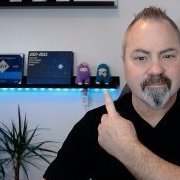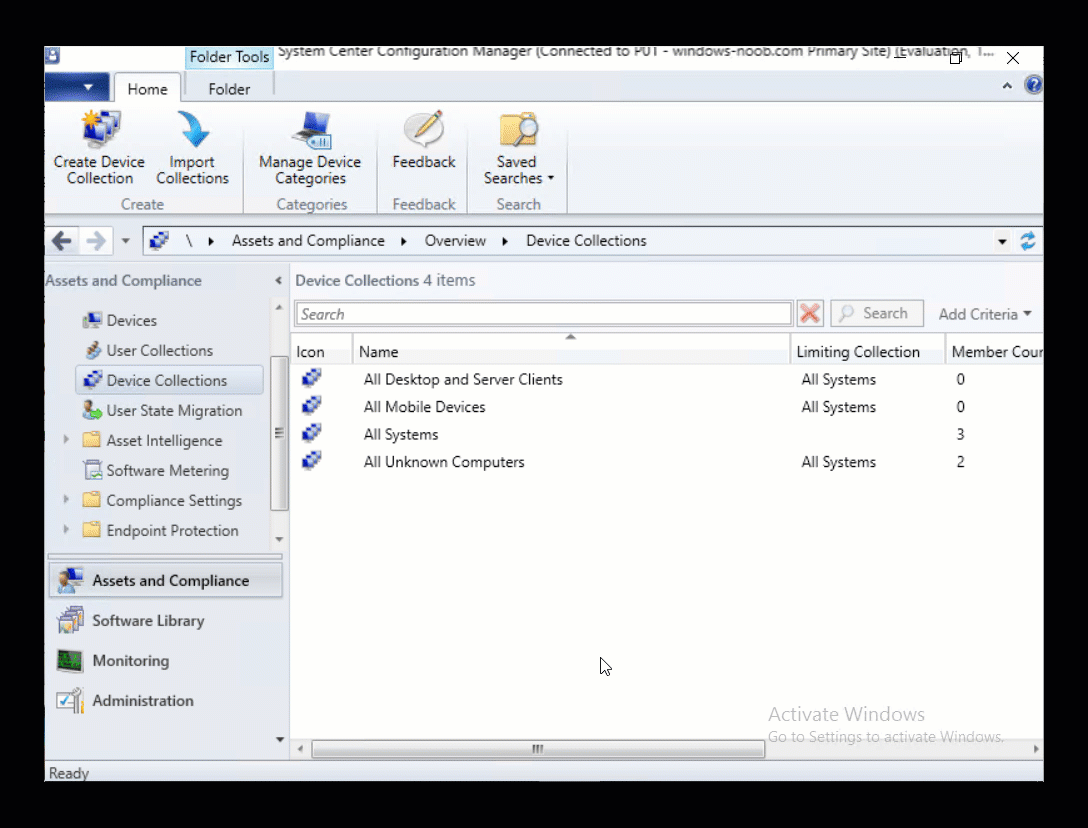-
Posts
9239 -
Joined
-
Last visited
-
Days Won
368
Everything posted by anyweb
-

Failed to install applications during task sequence
anyweb replied to JSlay33's topic in Configuration Manager 2012
the error means Required management point not found Source: System Center Configuration Manager ----- are you specifying something in relation to MP in the setup windows and configmgr step (in installation properties) ? what do the App*.log files reveal ? -

Configuring BitLocker in Intune - Part 2. Automating Encryption
anyweb replied to anyweb's topic in Microsoft Intune
did you look at the youtube video showing you how to test this ? here it is -

Problem deploy OS on computer that has 2 or more disks
anyweb replied to Scripteur's topic in Configuration Manager 2012
yup works ok for me, so before we go any further, can you explain where you got the error's you posted, and what happens when you run the code pasted directly above this reply on that machine (and not in the task sequence), does it produce an error, or not, or, do you only see an error when you run the script via the task sequence -
it's copied from the package source in the CCMCache or direct from the dp, what issues does this particular computer have ? bad battery ? can't you replace it with a new battery
- 242 replies
-
- 1702
- forced upgrade
-
(and 2 more)
Tagged with:
-

Problem deploy OS on computer that has 2 or more disks
anyweb replied to Scripteur's topic in Configuration Manager 2012
I can't see that you can use it if it produces errors when run during the task sequence, how can it set the variable if it doesn't work, do you see my point ? if I was using a script to set a variable i'd add a logging function to see where it's failing, below is an example function Function LogWrite { Param ([string]$logstring) $a = Get-Date $logstring = $a,$logstring Try { Add-content $Logfile -value $logstring -ErrorAction silentlycontinue } Catch { $logstring="Invalid data encountered" Add-content $Logfile -value $logstring } write-host $logstring } # script starts here $Logfile = "C:\Windows\temp\logfile.log" so for each action in your script use LogWrite "about to do... whatever" so you can see where it fails... once you fix the script, then you can use the variable in the task sequence -

Problem deploy OS on computer that has 2 or more disks
anyweb replied to Scripteur's topic in Configuration Manager 2012
but you pasted above that it's producing an error on line 7 ? -

Problem deploy OS on computer that has 2 or more disks
anyweb replied to Scripteur's topic in Configuration Manager 2012
so you are running an English PowerShell script on a French OS ? that might be part of your problem, "ASSOCIATORS OF" might be something else in French..just a thought have you actually tried running this script on that computer without running it in the task sequence, (New-Object -COMObject Microsoft.SMS.TSEnvironment).Value('OSDDiskIndex') = $MonDisk.Disk }" will fail as no task sequence is running but if your script works (and i'm not sure it is working), then you should get some valid output -

Problem deploy OS on computer that has 2 or more disks
anyweb replied to Scripteur's topic in Configuration Manager 2012
the first thing i'd say is why 2 disks ? and, when you say it's not working efficiently, can you explain what is not working exactly ? what errors are you seeing, and can you zip up and attach the smsts.log ? -
i'd suggest the Dell WinPE driver cab, if you look at the smsprov.log around the time of the failure, does it reveal the problem ?
-
it's just a popup, you can move it anywhere on the screen and use Windows File Explorer to free up space on C:\, have you tried that ?
- 242 replies
-
- 1702
- forced upgrade
-
(and 2 more)
Tagged with:
-
thanks for the comments and i'll consider that for the next time I update that script, they do take a lot of time to test and produce, but i'll definitely give it a try
- 20 replies
-
- sql server 2017
- powershell
-
(and 3 more)
Tagged with:
-
thanks for this addition, great idea and i'll try and incorporate it into a later version
- 242 replies
-
- 1702
- forced upgrade
-
(and 2 more)
Tagged with:
-
yup that's the current design, the idea is that the user should free up some space, after which it will continue.... do you think it should do something else, if so what ?
- 242 replies
-
- 1702
- forced upgrade
-
(and 2 more)
Tagged with:
-

Having issues booting to PXE (Current Branch)
anyweb replied to mas10's topic in Configuration Manager 2012
welcome to the forums ! first things first, you need to fix the mp before anything else, so when you reinstalled the mp, what do the mp.msi.log, mpcontrol.log and mpsetup.logs tell you about that reinstallation ? is the site in http or https mode ? -
This multi-part guide will show you how to install the latest baseline version of Configuration Manager from Microsoft. The latest available baseline version is System Center Configuration Manager (Current Branch) version 1802 as of March 29th 2018. How can I install System Center Configuration Manager (Current Branch) version 1802 on Windows Server 2016 with SQL Server 2017 – Part 1 How can I install System Center Configuration Manager (Current Branch) version 1802 on Windows Server 2016 with SQL Server 2017 – Part 2 How can I install System Center Configuration Manager (Current Branch) version 1802 on Windows Server 2016 with SQL Server 2017 – Part 3 How can I install System Center Configuration Manager (Current Branch) version 1802 on Windows Server 2016 with SQL Server 2017 – Part 4 You can use this multi-part guide to get a hierarchy up and running on Windows Server 2016 using SQL Server 2017. The concept behind this is to guide you through all the steps necessary to get a working Configuration Manager Primary site installed using manual methods or automating it by using PowerShell. This gives you the power to automate the bits that you want to automate, while allowing you to manually do other tasks when needed. You decide which path to take. PowerShell knowledge is desired and dare I say required if you are in any way serious about Configuration Manager. I will show you how to do most steps via two methods shown below, it’s up to you to choose which method suits you best but I highly recommend automating everything that you can (if possible), using PowerShell. Method #1 – Do it manually Method #2 – Automate it with PowerShell In Part 1, you configured Active Directory Domain Services (ADDS) on AD01, then joined the Configuration Manager primary server (CM01) to the newly created domain. You then created users, usergroups and OU's in Active Directory and created the System Management Container. Finally you delegated permission to the Configuration Manager server to the System Management container. In Part 2, you configured Windows Server 2016 roles and features on the Configuration Manager primary server (CM01) and then you downloaded and installed Windows ADK 1709. Next you installed SQL Server 2017 CU5 with SQL Server Management Studio (SSMS) and Reporting Services before installing the WSUS role which uses SQL to store the SUSDB instead of the Windows Internal Database (WID). In Part 3, you downloaded and extracted the ConfigMgr content, you downloaded the ConfigMgr prerequisites and then you extended the Active Directory schema before installing System Center Configuration Manager (Current Branch) version 1802. In this part you'll create some device collections to prepare your lab for Servicing Windows 10, whether using WAAS or Upgrade Task Sequences built into ConfigMgr. The collections create include some based on the recently released Windows 10 version 1803. Step 1. Create some device collections Note: Perform the following on the Configuration Manager server (CM01) as a Local Administrator You can create collections using the ConfigMgr console and clicking your way through the wizard, you'll need to add membership queries to populate the collections, and include Include or Exclude rules as appropriate. Method #1 – Do it manually <to be added> Method #2 – Automate it with PowerShell To automate the creation of a bunch of device collections simply run the CreateDeviceCollectionsWindows10.ps1 Powershell script by starting PowerShell ISE as Administrator on the ConfigMgr server (CM01). Summary In this guide you created a whole bunch of collections to sort all your Windows 10 computers into easily identifiable groups based on Windows Version number, so that you can target them with policy or use Upgrade task sequences or Windows Servicing. Downloads The scripts used in this guide are available for download here. Unzip to C:\Scripts on both servers. The scripts are placed in the corresponding folder (Part 1, Part 2 etc) and sorted into which server you should run the script on (AD01 or CM01). Scripts.zip
- 7 replies
-
- windows 10 1803
- device collections
-
(and 2 more)
Tagged with:
-

Help For Upgrade to 1802
anyweb replied to honestvip's topic in System Center Configuration Manager (Current Branch)
i can remote in via TeamViewer and take a look if you want, if so, pm me the details. -

Help For Upgrade to 1802
anyweb replied to honestvip's topic in System Center Configuration Manager (Current Branch)
have you rebooted the server ?



